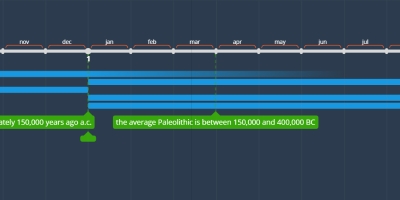Timeline
Category: Outro
Atualizado: 27 out 2017
Autores

Created byyineth soraida urrego urrego
Attachments
Eventos
Paleolithic
(2,500,000 a.c- 10,000 a.c)Lower Paleolithic
(2,500,000 a.c- 127,000 a.c)Middle Paleolithic
(127,000 a.c - 40,000 a.c)Upper Paleolithic
(40,000 a.c- 10,000 a.c)Mesolithic
(10,000 a.c - 8,000 a.c)Neolithic
(8,000 a.c - 6,000 a.c)Copper Age
(6,000 a.c - 3,600 a.c)Bronze Age
(3,600 a.c - 1,200 a.c)Iron Age
(1200 a.c - 200 a.c)The Mesoamerican Chronology
divides the history of pre-Columbian Mesoamerican
in different periods:
Paleo-Indian (first human inhabitants 3500 a.c),
Archaic (3500 BC-2000 a.c,
Preclassic (2000 a.c- 200 d.c),
Classic (200 d.c-1000 d.c),
and Postclassic (1000 d.c-1697 d.c)The Paleo-Indian period
(also called, Lítico, 10000 BC-3500 BC)
is the one that begins from the first signs
of human presence in the region, to the establishment of agriculture
and other practices : pottery and sedentary establishments)
and subsistence techniques characteristic of proto-civilizations.2000 a. C.-200 d. C.
During the Preclassic
the large scale ceremonial architecture,
the writings, the cities and the states(200-1000)
The Classic was dominated
by numerous independent city-states in
the Mayan region and
the principle of political unity was also given
n central Mexico and Yucatan.(1000-1697)
In the Postclassic many
of the great nations
and cities of the Classic collapsed,
although some continued,
such as Oaxaca, Cholula
and the Mayan cities
of Yucatan such as Chichen Itza and Uxmal.
It is sometimes seen as a period of chaos and wars.Middle Ages until 1453,
fall of the Eastern Roman Empire.
The Modern Age
is the third of the historical periods
in which universal history is conventionally divided,
understood between the century
XV and XVIIIIn the Modern Age were found the two
"worlds" that had remained
almost completely isolated
from Prehistory: the New World (America)
and the Old World (Eurasia and Africa).The rich, inhabitants of towns or cities,
formed a new social class, increasingly rich economically,
which would enable them in the
mid-eighteenth century
with technological success, become models
of factories and store profits,
at the expense of work
in conditions degrading, of their workersPeríodos
Paleolithic
(2,500,000 BC - 10,000 BC)
Comments